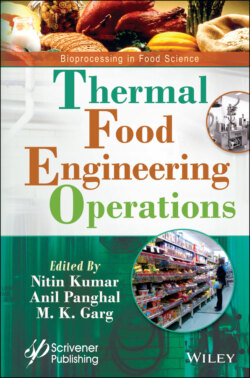Читать книгу Thermal Food Engineering Operations - NITIN KUMAR - Страница 55
2.6.5.2 Application for Inactivation in Food Sector
ОглавлениеThe effect of inactivation rate and food quality while using the ohmic heating process has been widely studied in several reports. E. coli inactivation was done for goat milk using ohmic heating at 50 Hz where the electric field was adjusted and the whole process was compared with the traditional method [85]. The log reduction was significantly reduced when it was done using ohmic heating as compared to the conventional water bath process. For orange juice, the decontamination was done using ohmic heating for moulds, yeast, and bacteria at 50 Hz with varying temperatures. This was also compared with the traditional one which was done using 90°C for 50 s. The results showed that the reduction or the inactivation processing ohmic heating was 98% with only 15% reduction of vitamin C plus the product did not get degraded any of its qualities and was fresh when compared with the conventional pasteurized one [86]. Shelf life during storage of both the sample treated differently at 48°C extended in case of ohmic heated one up to 100 days which was almost twice as seen in traditionally treated pasteurized process product plus preserving the flavors and nutritional attributes.
[87] showed comparable outcomes in which apple juice was treated through ohmic heating for L. monocytogenes and Salmonella Typhimurium. It was observed the log reduction was 5 CFU/mL at 20Hz which was treated for 30 s without disturbing the superiority of the juice. These conclusions specify that ohmic heating is acceptable for the decontamination of microbes in juices.
When meatballs were subjected to ohmic heating to inactivate the mesophilic moulds, bacteria, and yeast with the following parameters (75°C, 50 Hz, 0 s holding time, 15.26 V/cm). The inoculation was done for Listeria innocua and the outcome was compared with the conventional process. The traditional process consumed much time, i.e., 150 min as compared to sample treated through ohmic heating which varied from 7-15 min [88]. During and after the storage the sample treated with ohmic heated showed a longer shelf life of 21 days with maintained product quality. From all the above studies it was testified that ohmic heating is considered prominent to yield a higher-end product in terms of quality and safety for both solid and semisolid food with minimum heating time as compared to traditional heating or water bath.
Similarly, ohmic heating works significantly in inactivation spores from food products. Ohmic heating was used to treat B. licheniformis spores present in cloudberry jam at 50 Hz [85]. The sample was also heated with the water bath and the electric field was adjusted according to that. It was observed that the reduction of log cycles was observed perfectly with the sample heated with ohmic heating rather than a simple water bath at high temperature. B. cereus spores found in doenjang were shrunken when ohmic heating with parameter 26.7 V/cm at 25 kHz was applied for the 60 s [81], though the temperature was maintained up to 105 °C, the quality and color were yet suitable for the customers. The main advantage of ohmic heating is that the time required is reduced to a significant level adding to the efficacy of the inactivation process; additionally, it provides quality preservation assurance, and hence thereby enhanced shelf life. Therefore, gathering all the above context with every study is done to improve the process to attain higher consistency.
